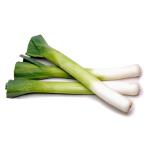Hello all and Happy New Year! It is 2013 and let’s join forces to make this year a good one! Let’s keep it going with a new week of great organic produce. This week, we are focusing on two wonderful items: Lacinato Kale and Leeks.
Both winter-favorites, these two items can be prepared deliciously together or separate. We’ve discussed both kale and leeks before, but as they are so versatile and often understated, we thought we should definitely remind you all about them in this new year!
Lacinato Kale is a hearty, but tender green full of nutrients and flavor! A leafy green, kale is available in curly, ornamental, or dinosaur varieties. It belongs to the Brassica family that includes cruciferous vegetables such as cabbage, collards, broccoli, and Brussels sprouts.
is available in curly, ornamental, or dinosaur varieties. It belongs to the Brassica family that includes cruciferous vegetables such as cabbage, collards, broccoli, and Brussels sprouts.
Kale’s health benefits are primarily linked to the high concentration and excellent source of antioxidant vitamins A, C, and K — and sulphur-containing phytonutrients.
So just how do you prepare this green? Check out these great recipes and let us know what you think! If you’re not in love with kale yet, prepare to fall.
 Leeks, too, are versatile and delicious! Very unique, leeks are root vegetables that look quite similar to onions, their cousin veggie. Their flavor is onion-like but much milder. If you’re not an onion fan, try leeks. Their flavor is mellow and not overpowering, and many onion-haters enjoy them.
Leeks, too, are versatile and delicious! Very unique, leeks are root vegetables that look quite similar to onions, their cousin veggie. Their flavor is onion-like but much milder. If you’re not an onion fan, try leeks. Their flavor is mellow and not overpowering, and many onion-haters enjoy them.
Unlike onions, leeks don’t form much of a bulb on the end of the root. Instead, they remain cylindrical, with perhaps a slight bulge at the end. The part of that is under ground remains tender and white, while the part exposed to the sunlight becomes tough and fibrous and not very good for eating. To maximize the edible part of the plant, farmers mound the dirt up around the sprouting plant; this keeps more of it underground and white, but also means that dirt often gets between the layers, so leeks need careful cleaning before cooking. (WiseGeeks)
Do you know the best way to cook leeks? Share your recipe on our Facebook page! If you haven’t mastered this root yet, check out these tips and recipes!




